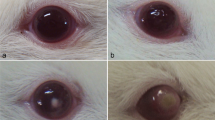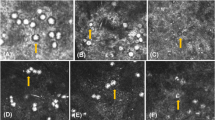Abstract
Amoebic keratitis, a sight-threatening, progressive corneal disease, is commonly caused by ubiquitous, pathogenic, free-living Acanthamoeba spp., which are widely distributed in the environment. We investigated clinical findings and histology of Acanthamoeba keratitis in a rat cornea model. Experimental Acanthamoeba keratitis was induced in Wistar rats by intrastromal inoculation of Acanthamoeba castellanii trophozoites. The clinic features of Acanthamoeba keratitis by day 70 are observed. All rats inoculated with Acanthamoeba developed keratitis. Histologically, the eyes displayed blood vessels, edema, and amoebae in stroma. A mixed cellular response, including neutrophils, mononuclear cells, and spindle-shaped cells, was seen. In conclusion, progressive, suppurative Acanthamoeba keratitis can be induced in the rat cornea model. This rat cornea model assists researchers who study the pathogenesis of Acanthamoeba keratitis and devise treatment for this difficult condition.




Similar content being viewed by others
References
Aksozek A, McClellan K, Howard K, Niederkorn JY, Alizadeh H (2002) Resistance of Acanthamoeba castellanii cysts to physical, chemical, and radiological conditions. J Parasitol 88:621–623
Awwad ST, Petroll WM, McCulley JP, Cavanagh HD (2007) Updates in Acanthamoeba keratitis. Eye Contact Lens 33:1–8
Bacon AS, Frazer DG, Dart JK, Matheson M, Ficker LA, Wright P (1993) A review of 72 consecutive cases of Acanthamoeba keratitis, 1984–1992. Eye 7:719–725
Badenoch PR, Johnson AM, Christy PE, Coster DJ (1990) Pathogenicity of Acanthamoeba and a Corynebacterium in rat cornea. Arch Ophthalmol 108:107–112
Berger ST, Mondino BJ, Hoft RH, Donzis PB, Holland GN, Farley MK, Levenson JE (1990) Successful medical management of Acanthamoeba keratitis. Am J Ophthalmol 110:395–403
Illingworth CD, Cook SD (1998) Acanthamoeba. keratitis. Surv Ophthalmol 42:493–508
Jones DB (1986) Acanthamoeba. —the ultimate opportunist? Am J Ophthalmol 102:527–530
Khan NA (2001) Pathogenicity, morphology, and differentiation of Acanthamoeba. Curr Microbiol 43:391–395
Khunkitti W, Lloyd D, Furr JR, Russell AD (1998) Acanthamoeba castellanii. : growth, encystment, excystment and biocide susceptibility. J Infect 36:43–48
Kremer I, Cohen EJ, Eagle RC Jr, Udell I, Laibson PR (1994) Histopathologic evaluation of stromal inflammation in Acanthamoeba keratitis. CLAO J 20:45–48
Larkin DF, Easty DL (1990) Acanthamoeba. keratitis: I. Preliminary findings. Br J Ophthalmol 74:551–555
Larkin DF, Easty DL (1991) Experimental Acanthamoeba keratitis. II. Immunohistochemical evaluation. Br J Ophthalmol 75(7):421–424
Lindquist TD (1998) Treatment of Acanthamoeba keratitis. Cornea 17:11–16
Marciano-Cabral F, Cabral G (2003) Acanthamoeba spp. as agents of disease in humans. Clin Microbiol 16:273–307
Martinez AJ (2001) Free-living amebas and the immune deficient host. In: IX International Meeting on the Biology and Pathogenicity of Free-living Amoebae Proceedings, pp 1–12
Mathers W, Stevens G, Rodriguez M, Chan CC, Gold J, Visvesvara GS, Lemp MA, Zimmerman LE (1987) Immunopathology and electron microscopy of Acanthamoeba keratitis. Am J Ophthalmol 103:626–635
Moore MB, McCulley JP (1989) Acanthamoeba. keratitis associated with contact lenses: six consecutive cases of successful management. Br J Ophthalmol 73:271–275
Niederkorn JY, Alizadeh H, Leher H, McCulley JP (1999a) The pathogenesis of Acanthamoeba keratitis. Microbes Infect 1:437–443
Niederkorn JY, Alizadeh H, Leher HF, McCulley JP (1999b) The immunobiology of Acanthamoeba keratitis. Springer Semin Immunopathol 21:147–160
Schuster FL (2002) Cultivation of pathogenic and opportunistic free-living amebas. Clin Microbiol 15:342–354
Tabin G, Taylor H, Snibson G, Murchison A, Gushchin A, Rogers S (2001) Atypical presentation of Acanthamoeba keratitis. Cornea 20:757–759
Walochnik J, Obwaller A, Aspock H (2000) Correlations between morphological, molecular biological, and physiological characteristics in clinical and nonclinical isolates of Acanthamoeba spp. Appl Environ Microbiol 66:4408–4413
Acknowledgments
We thank Julia Walochnik of the Department of Medical Parasitology, Clinical Institute of Hygiene, University of Vienna, Vienna, Austria, for providing A. castellanii strain 1BU.
Author information
Authors and Affiliations
Corresponding author
Rights and permissions
About this article
Cite this article
Polat, Z.A., Ozcelik, S., Vural, A. et al. Clinical and histologic evaluations of experimental Acanthamoeba keratitis. Parasitol Res 101, 1621–1625 (2007). https://doi.org/10.1007/s00436-007-0704-7
Received:
Accepted:
Published:
Issue Date:
DOI: https://doi.org/10.1007/s00436-007-0704-7




